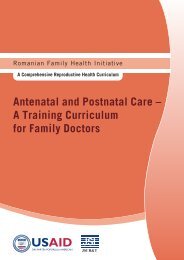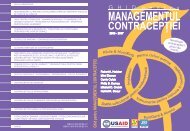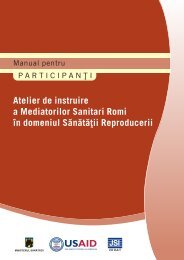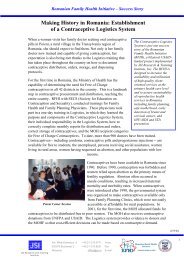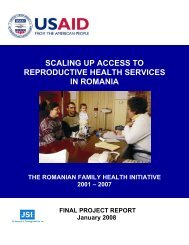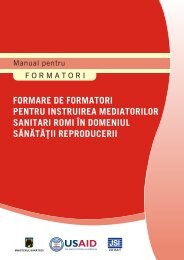Training of Roma Health Mediators in Reproductive Health
Training of Roma Health Mediators in Reproductive Health
Training of Roma Health Mediators in Reproductive Health
Create successful ePaper yourself
Turn your PDF publications into a flip-book with our unique Google optimized e-Paper software.
Participant document<br />
FREQUENT ASKED QUESTIONS<br />
What if a woman forgets whether or not she has moved the r<strong>in</strong>g on her CycleBeads?<br />
We recommend that a woman who uses CycleBeads also use a calendar to mark the first<br />
day <strong>of</strong> her cycle – the day her period starts. That way, if she is not sure whether or not she<br />
has moved the r<strong>in</strong>g on any particular day, or whether it may have been moved<br />
accidentally, she can check her calendar. To confirm that the r<strong>in</strong>g is on the correct bead,<br />
she counts from the day she started her period up until today, and then counts the same<br />
number <strong>of</strong> beads. The r<strong>in</strong>g should be on the correspond<strong>in</strong>g bead on her CycleBeads.<br />
How do couples normally manage the 12-day fertile time?<br />
Couples have used different strategies for manag<strong>in</strong>g the fertile time. The method allows<br />
users to be aware <strong>of</strong> the days dur<strong>in</strong>g the menstrual cycle when there is a possibility <strong>of</strong><br />
pregnancy. Couples who use the SDM may choose to manage their fertile days <strong>in</strong><br />
different ways. Some couples prefer to avoid <strong>in</strong>tercourse completely dur<strong>in</strong>g the fertile<br />
days. Other couples prefer to use condoms or other barrier methods dur<strong>in</strong>g the fertile<br />
days. The most important element, however, to manag<strong>in</strong>g the fertile period is open<br />
communication between both partners.<br />
What if the woman th<strong>in</strong>ks that she might be pregnant?<br />
If the woman th<strong>in</strong>ks she might be pregnant or if 42 days or more have passed s<strong>in</strong>ce her<br />
last period started, she should be referred for a pregnancy test. If the pregnancy test is<br />
negative and this is the first time that her cycle is out <strong>of</strong> the 26-32 day range, she may<br />
cont<strong>in</strong>ue to use the method with caution. She should return if she has a delayed period<br />
aga<strong>in</strong>. If the test is positive, <strong>of</strong>fer her appropriate counsel<strong>in</strong>g and refer the woman for<br />
prenatal care.<br />
What if the woman reports bleed<strong>in</strong>g between periods?<br />
In case <strong>of</strong> m<strong>in</strong>or spott<strong>in</strong>g, <strong>in</strong>form the woman that this is probably a normal sign <strong>of</strong><br />
impend<strong>in</strong>g ovulation, rather than a sign <strong>of</strong> a health problem. Otherwise, counsel her<br />
accord<strong>in</strong>g to the service delivery guidel<strong>in</strong>es or refer her for an assessment for unusual<br />
vag<strong>in</strong>al bleed<strong>in</strong>g.<br />
97<br />
RFHI <strong>Tra<strong>in</strong><strong>in</strong>g</strong> <strong>of</strong> RHMs <strong>in</strong> <strong>Reproductive</strong> <strong>Health</strong> Session 5: SDM



